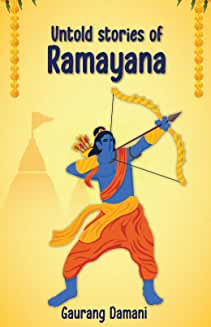 Dasharatha of the Suryavanshi (solar) dynasty ruled from Ayodhya. The beautiful city had many 7-storied buildings, theatres, and parks. Ayodhya had innumerable well-decorated temples that resonated with the sound of divine Vedic chants. Ayodhya was inhabited by Brahmana-s (the learned scholars) as well as talented artisans.
Dasharatha of the Suryavanshi (solar) dynasty ruled from Ayodhya. The beautiful city had many 7-storied buildings, theatres, and parks. Ayodhya had innumerable well-decorated temples that resonated with the sound of divine Vedic chants. Ayodhya was inhabited by Brahmana-s (the learned scholars) as well as talented artisans.
By mistake, Dasharatha had killed Shravana, the son of a Vaishya (business-oriented) father and a Shudra (service-oriented) mother. The king called Shravana’s ascetic father a Rishi muni who remarked that since Dasharatha killed their pious son out of ignorance, the sin of Brahmana hatya would not affect him right away but after some time. The sad Vaishya sage cursed the Kshatriya king that he will die pining for his son’s return. This narration in Valmiki Ramayana shows the fluidity of varna.
During Dasharatha’s putreshti yagnya, he was advised to treat with genuine respect all the attending Brahmana-s, Kshatriya-s, Vaishya-s, and Shudra-s. His kulaguru Vasishtha stated that actions performed with disrespect or deception do not give any benefits.
Dasharatha also donated many cows and gifts to Brahmana-s for the welfare of his family, after the birth of his 4 sons and their weddings. 12 years later, before leaving for a forest exile, Rama too donated wealth to the Brahmana-s, elder people, and the needy. These examples highlight the status of learned scholars of the Vedic scriptures.
During their exile, many sages asked Rama for protection from the Rakshasa-s who disrupted their Dharmic practices. Rama replied that a true Kshatriya wears his weapons to eradicate the word ‘distressed’ from Earth. It is his duty as a Kshatriya to protect all the oppressed citizens from harm.
At the start of the 14th year of their exile, Ravana kidnapped Seeta by deceit and told her it is the nature of Rakshasa-s to do so. Ravana’s father was a Brahmana Rishi named Vishravas, but his mother Kaikasi was a hybrid descendant of a Rakshasa and a Pishachini. Valmiki Ramayana’s Aranya kaanda and Uttara kaanda state that Ravana used to destroy yagnya-s and eat Brahmana-s who performed these fire rituals.
Rama took the help of Hanuman and the vanara-sena to kill Ravana. Rama returned to Ayodhya with Seeta, Lakshmana, Vibhishana, and the vanara Generals. During his coronation, Rama donated many gifts to Brahmana-s and those who helped him win the war.
A little later, the royals embarked on a teertha yatra. In the auspicious Dharmaranya (present-day northern Gujarat state), he resettled 18,000 Brahmana-s who had fled due to the fear of an Asura. He donated 4,400 nearby villages to the Brahmana-s. He gave wealth to 36,000 Vanik-s (merchants) and told them to attend to the needs of the Brahmana-s. The grateful ascetics chanted “Rama Rameti Rameti” and declared that a devotee who regularly chants this mantra will be released from his past sins.
Back in Ayodhya, Rama opened a free bhojnalaya to feed all the needy people from the Brahmana-s to Chandala-s till he was the ruler. Rama’s reign is called Rama Rajya because his citizens were prosperous, content, and happy. People lived long and no one performed the last rites of their children.
But once a person approached and blamed Rama for the premature death of his young son. Devarishi Narada appeared and stated that a man of vicious understanding was performing an unusual tapasya that caused this child’s death as a bali (sacrifice). Only the death of that wicked man can bring the youth back to life. Rama was not aware of the varna of this man when he set out.
After an extensive search, Rama found a person hanging upside down from a tree and performing an Asuric penance. Shambuka, who happened to be a Shudra, said that he wanted to reach heaven in his physical body and conquer it. But even Suryavanshi King Trishanku, father of the illustrious Harishachandra, could not do so. Lakshmana had killed Indrajit, a Brahmana’s grandson, for performing an Asuric yagnya. Thus, Rama killed Shambuka as a punishment for performing a demonic penance that caused harm to others. The Deva-s appeared and stated that the youth had regained his life the moment Shambuka was killed.
Ramayana gives many examples that varna is not discriminatory or by birth alone, but based on our present actions. Rama had eaten the half-eaten berries of Shabari, his tribal devotee whose Guru was Rishi Matanga (today’s Scheduled Caste). On returning to Ayodhya, Rama honoured his Nishada (Scheduled tribe) friend Guha who had helped him during his exile. Also, Valmiki was a robber before he became a Maharishi and the author of the epic Ramayana.

This article is an excerpt from the book
‘Untold stories of Ramayana‘ by Gaurang Damani
This article also appeared on the Hindu Post website
